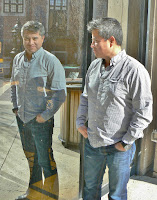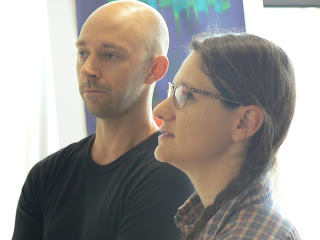Saturday August 12th Stephanie Leedy opened her building for the ever popular Show and Tell event. Nine collectors shared stories about TWO inked works from their personal collections. Seventeen enjoyed the informal program by the Nelson Atkins Print Society.
"Artist Statement by Ben Beres. This etching has tiny words and sentences that do not make any sense. Even after ten minutes of study the content is unintelligible. I think that is the point Beres is trying to make about artist statements. I love this piece." Paul Sokoloff
More on Ben Beres here
Curtis Smith shared a two color lithograph by the Italian print maker Alda Fana
"Giuseppe Vasi modified the dress of people on his etched plates for the purpose of tourism." David Mc Gee
For more about Vasi the etcher.
Susan Lawrence and Charlie Paynter presented collaboration work by Ben Shahn and Leonard Baskin. Entitled "Beatitudes." It was a print from her parents.
Etcher Andre Zorn is known for his particular style using parallel lines. Steve Pruitt
When I participated in the 2011 Exchange #3 black and white prints through Lets Trade Prints, I received twenty-two other inked works from Australia, France, Russia, Canada, Pennsylvania, Minnesota, Illinois, Wisconsin, Washington, Maryland, and California. In the post was the lino cut, River Bank by Elizabeth Burton from Queensland, Australia. Karl Marxhausen
John Mallery showed us a high-end archival box for prints, above.
"Maritime etchings of Arthur Briscoe came from his first-hand experiences on the sea." John Mallery
"In the lithograph Nemesis by Austin Osman Spare, the artist depicts signals from the unconscious mind. At the bottom of the print you can see the nose of the dreamer, above which is a portrait of the artist. Some called Spare the father of surrealism." Paul Sokoloff
Passing around an illumined magnifying glass, members studied the fine details of boxwood engravings by Thomas Berwick. The Newcastle map and photos also were passed around.
"Many of his hard wood engravings appeared in children's books. Berwick learned the trade in from the Newcastle engraver Ralph Bailey. Berwick walked the three mile route everyday and you can walk the same route today when you are in Newcastle. I have." Paula Winchester
"My son David was in fifth grade when he did this lino cut impressions for the haunted house challenge. He must have spent twenty minutes cutting on this lino cut block every evening. He got help from our neighbor Russell Ferguson." Curtis Smith
A lithography by Elizabeth Layton
Seven minutes. Part 1
Don Lambert related his encounters with Elizabeth Layton
"Elizabeth did a drawing called Censored. Where she has been censored. Her principles have been crossed out. Inspired by the drawing, she did this lithograph. This was produced by The Lawrence Lithography Workshop, that is Mike Sims in Kansas City. It was done in edition of one hundred and they all sold." Don Lambert
Two minutes. Part 2. Layton's print "Remembering Names," next.
After I saw the woodblocks Herschel Logan carved out at the Beach Museum of Art in Manhattan, Kansas - I learned by trying it myself. Designs drawn first, next cuts on a linoleum block. The largest learning curve for me was inking twenty-three impressions that looked alike.[check LINK] What a headache!! The result was my lino cut called Moss Creek #1. I tried to do a sky like J.J. Lankes might do. Karl Marxhausen
Steve Pruit shared lithograph by Childe Haasam (1859-1935), after the series of Flag paintings.
show and tell event,
August 12, 2017






















































